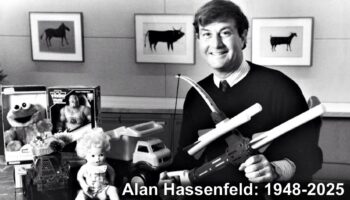Industry legends Richard C. Levy and Ronald O. Weingartner on how to pitch ideas

Remember the old saying? That if a man builds a better mousetrap, even though his house may be deep in the woods, the world will beat a path to his door?
Well, this may have been true in 1889 when American essayist Ralph Waldo Emerson penned it… But it’s not true today’s world of toy-and-game invention! In fact, for the most part, it’s the opposite…

Inventors of playthings must be prepared to beat a path to a manufacturer’s door. Once there – more often than not – after a long hard slog, the door might be locked.
The consensus among the pros we interviewed for ‘The Toy and Game Inventor’s Handbook’ is that successful invention works out to about 10% creativity – and 90% tenacity and marketing skills. And while creativity is a natural gift – either you have it or you don’t – marketing skills, although intuitive, can be learned through experience.
This means amateur toy-and-game inventors become pros the same way amateur athletes do… Through training and competition. Bud Grant, a former coach of the NFL’s Minnesota Vikings, once said that players practice hard so that when the ball bounces their way on Sunday afternoon, they know what to do with it. The same preparation holds true for inventors. Flesh out, define, and identify the unique strengths of an idea so when granted an appointment with a marketer, the most is made of the opportunity.
It takes a stimulating presentation, one that is marinated in excitement, personal and conceptual; relationships; quality prototypes, breadboards or renderings; and the technical savvy to establish and land a commitment to a significant next step.
As Michael Rinzler, Executive VP/Partner at Jazwares says: “We see over 5,000 concepts a year. The inventors that stand out have an acumen on how to present their concepts in an articulate, concise and entertaining way. The toy business is akin to the entertainment business – and showmanship goes a long way.”

Today, you can also expect a licensee’s commitment to be a protracted process. Few ideas are licensed when pitched. However, from another era, stories abound about inventors licensing their ideas at the moment of presentation. For example, veteran inventor Joe Wetherell, creator of Scrabble Slam and the FLOAM modeling compound, tells how Mattel president Jill Barad – a brilliant, self-confident, marketing phenom – licensed FLOAM at first sight. Launched in 1994, FLOAM generated $30 million for Mattel.
According to Stephanie Janis, co-inventor of the classic board game Girl Talk, that item was also licensed on the spot at the pitch. It went on to sell over 1 million units for Western Publishing from 1987 on.
Well… That was then – but now is now. Today, few execs swing at the first pitch. Decisions are made more and more by committees comprised of people who are spectators, not athletes. By the time they get done overstudying an opportunity, the opportunity is gone. They fall victim to the paralysis of analysis. They’re so busy pondering statistics they forget they can create statistics. They’re so busy measuring public opinion that they forget they can mold it.
Once people are part of a committee, their ability to make “gut” decisions based upon empirical, industry experience, product sensitivity and consumer awareness is diluted. ‘Groupthink’ takes over. Doers become reviewers.
As Bob Moog, president and co-founder of University Games says: “In this age of corporate and bureaucratic obsession, the creative inventor serves as a constant reminder that the business is about finding fun for kids, and playing Santa Claus…”

In some ways, the inventor pitch session is like a relay race. In it, the baton – the submitted idea – is passed on to the next runner. So the inventor starts the race and must deliver a performance that inspires the next carrier to run just as fast as the inventor ran on the first leg. If the inventor is slow out of the blocks, juggles the baton, or runs out of energy during the pitch, don’t expect the executive to be motivated…
A new idea is a delicate thing. To riff on a thought by the Roman poet Ovid, the idea can be killed by a sneer or a yawn; it can be stabbed to death by a quip and worried to death by a frown on the right executive’s brow.
With that in mind, here are eleven building blocks for a strong presentation:
1. Instructions: Write a step-by-step, illustrated, instruction sheet. Take nothing for granted. An inventor’s worst nightmare is that someone at the company forgets how to operate the submission. Ideally, take time to produce a pitch video and post it on a private YouTube space.
2. Play Value: Share the results of any independent testing or “kitchen research” you have conducted. Include photos or videos of test sessions.
3. Engineering: If possible, include any technical back-up that will give a licensee’s engineers or designers a head start.
4. Manufacturing: If the idea requires a new material or unusual production process known to you, share as much of that information with the prospective licensee as possible. Ultimately, execution rests with the manufacturer, but shared information strengthens the partnership.
5. Marketing: Create a marketing 1-sheet that explains what makes the idea unique. Suggest where the item might fit into the market relative to pricing, competition, newness and “hook.” Do not tell a manufacturer how many millions of units it will sell unless you have a factual basis for projections. No need for pie-in-the-sky projections. They become meaningless once a product is in the hands of the Toy Gods.
Roger Shiffman, one time president of Tiger Electronics, when asked how many units he had to sell to consider Furby a hit in 1998, responded 250,000. Between October 2nd, when the creature was introduced at FAO Schwarz, NYC, NY, and the end of the year, Furby sold 4 million units.

Describing Tiger in 1998, Wired magazine wrote: “The team at Tiger seems to thrive on beating the odds – they’re gamblers at heart.”
The toy business grows through the efforts of entrepreneurial inventors and intrapreneural executives to whom the elves still whisper. They operate in a Never Never Land where pumpkins turn into coaches, mice into horses, cows jump over the moon, and dishes run away with spoons. A high-wire act with no safety net, the toy business is not for the faint of heart.
6. Intellectual Property: Patents: It is always wise to have a patent search conducted and share the results. First and foremost, you want to be able to tell the prospective licensee that your concept does not infringe prior art. If, at the same time, you find that the idea is patentable, this is also good to know and may influence the company’s decision.
Money Saving Idea: If you go through a law firm to order a search, it is much more expensive than hiring a patent searcher yourself. The law firm will jack up the search cost sometimes three times justifying it by telling the inventor an opinion on patentability will be included. But do you really need an opinion on patentability if the results of the search are obvious one way or another?
Virginia-based Greentree Information Services has been in business since 1991, owned and operated by George Harvill. GIS has extensive experience in toys and games and uses an international database. To check current search rates, email George at: [email protected].

7. Trademarks: A good trademark can often push a submission over the finish line. Trademark searches can be conducted by the inventor through Google or other internet search engines and your country’s trademark office. These sources should be checked. It is a waste of money to pay a law firm or professional searcher for a preliminary look.
In the United States, there is an Intent-to-Use (ITU) option that many inventors take. You may file even before you use your mark in commerce, which means you can get an earlier application filing date than a possible competitor. This could mean your mark has priority over someone else’s if a legal conflict develops or could develop — at the USPTO or in the marketplace. To check the current American TM fees: https://www.uspto.gov/trademarks/trademark-fee-information
8. Advertising: It is always a nice touch if you can provide some clever tag lines, slogans, and the like which may be used as packaging copy or in a promotion campaign. Even if unused, this shows you are thinking about the bigger picture, life after production. Also, what you propose might trigger something from the licensee team.
9. Social Media: If the concept has a natural tie-in with virtual networks and on-line communities, point it out. If there is an influencer that might be beneficial to the product launch, suggest the person.
10. Packaging: The industry has gone toward standardized packaging sizes and footprints more so with games than toys. But if you have a novel approach to how you ultimately see your product displayed at shelf level, there is no harm to submit a package design that shows the product’s visual strengths when on retail display.

11. Future: Through marker renderings and explanatory text, illustrate accessories, line extensions, and a potential future direction for your concept. It doesn’t hurt to show the marketer that you’re thinking beyond the core idea. These representations also provide a record of who originated the extensions, should this become an issue in the future.
In today’s environment – for obvious reasons – there has been a reduction in the number of in-person meetings to present ideas. Physical presentations maybe replaced with “virtual” presentations where inventor and the marketer audience are not in the same room or even the same country. Practice the presentation as it will be seen through the lens of a camera rather than presence of in-place audience eyeballs.
“A well-orchestrated video or Zoom presentation can be the difference between a company taking or passing on an item,” says Michael Rinzler of Jazwares.
However, the setting for the pitch, it is showtime and staging and flow should be well orchestrated. Practice the messaging you want to impress in every piece of the pitch points noted above. If there is a prototype showing the idea, a breakdown is inexcusable and no first aid kit can correct time lost with impatient viewers. It may not be Broadway, but when the curtain goes up on the Pitch, be ready for lights, camera, SELL!
About the Contributors
Richard C. Levy has negotiated countless IP licenses for toys, games and books. These include the deals for the million plus unit selling games Adverteasing (Cadaco); and Men Are from Mars, Women Are from Venus (Mattel) and global phenom Furby (Hasbro).
Ronald O. Weingartner experienced nearly 30 years in the industry with Milton Bradley and Hasbro, including a stint as Vice President of Inventor Relations at Hasbro Games. He has dealt with license agreements throughout his career.
The third edition of Richard and Ron’s Toy & Game Inventor’s Handbook includes templates for an option and license agreement. The license agreement is annotated by experienced inventors and agents.
Here’s what people say about The Toy and Game Inventor’s Handbook, which hit #2 on Forbes list of the 33 Best Books Recommended by Shark Tank Entrepreneurs:
“More than peeking behind the veil. Richard and Ron shine a klieg light on the heretofore private world of toy and game invention, licensing and marketing. A must read for anyone who ever wanted to dance the dance and collect the coin.”
Brian Hersch, licensor of many games including Taboo and Outburst.
“This is an essential book for every inventor who creates toys and games, and for corporate executives who license and market them.”
Greg Hyman, co-inventor Tickle Me Elmo, Talking Barney and many other toys and games.
“Richard and Ron bring a combination of 60 years of experience in invention and licensing, and obvious passion for new ideas to the most carefully researched and well written inventor resource I have read… A must-have volume for aspiring inventors.”
Stevanne “Dr. Toy” Auerbach, Ph.D.
“A treasure trove of information… Encyclopedic in scope and depth. Just about any question you could imagine isn’t just answered but explored from several angles.”
Richard Pachter, The Miami Herald.
—-
To stay in the loop with the latest news, interviews and features from the world of toy and game design, sign up to our weekly newsletter here
























